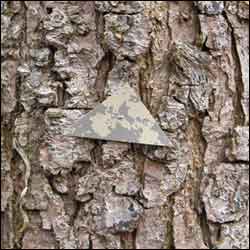What the eye doesn’t see …

An artificial moth on tree bark.
The first experimental evidence that birds can be deceived by camouflage in the same way that humans are deceived, is published today in Nature [3 March 2005].
The idea that bold contrasting colours help to break-up the body’s outline was rapidly adopted by many armies as long ago as the First World War. And in biology this idea of ‘disruptive colouration’ has long been used to explain how insects such as moths conceal themselves from predators, shaping the evolution of protective coloration in insects.
Innovative research from the University of Bristol provides the strongest evidence to date that disruptive patterns do indeed protect insects from detection by birds, the predator most likely to have shaped the evolution of protective coloration in insects.
Professor Innes Cuthill and his team pinned artificial ‘moths’ to trees in a field with a dead mealworm attached. The ’moths’ were triangular pieces of waterproof card with specific patterns printed on them. By varying the colours, size and location of patterns on the moths the team were able to mimic real tree characteristics and identify which pattern combinations were the most successful.
Professor Innes Cuthill said: “The rate at which mealworms were eaten by birds gives a measure of how effective each combination was at preventing detection by a predator. Combinations that gave a better disguise took longer to be seen, and it therefore took longer for the mealworms to be eaten.”
This research provides the first evidence that patterns which deceive humans operate in a similar way to those in non-human predators such as birds.
Media Contact
More Information:
http://www.bristol.ac.ukAll latest news from the category: Life Sciences and Chemistry
Articles and reports from the Life Sciences and chemistry area deal with applied and basic research into modern biology, chemistry and human medicine.
Valuable information can be found on a range of life sciences fields including bacteriology, biochemistry, bionics, bioinformatics, biophysics, biotechnology, genetics, geobotany, human biology, marine biology, microbiology, molecular biology, cellular biology, zoology, bioinorganic chemistry, microchemistry and environmental chemistry.
Newest articles

A universal framework for spatial biology
SpatialData is a freely accessible tool to unify and integrate data from different omics technologies accounting for spatial information, which can provide holistic insights into health and disease. Biological processes…

How complex biological processes arise
A $20 million grant from the U.S. National Science Foundation (NSF) will support the establishment and operation of the National Synthesis Center for Emergence in the Molecular and Cellular Sciences (NCEMS) at…

Airborne single-photon lidar system achieves high-resolution 3D imaging
Compact, low-power system opens doors for photon-efficient drone and satellite-based environmental monitoring and mapping. Researchers have developed a compact and lightweight single-photon airborne lidar system that can acquire high-resolution 3D…





















